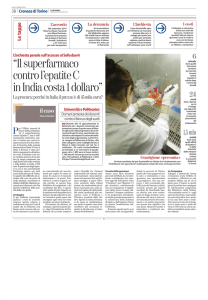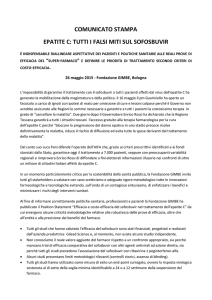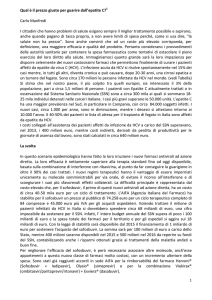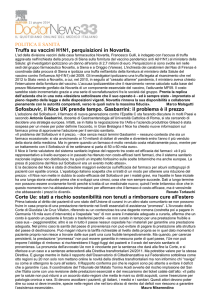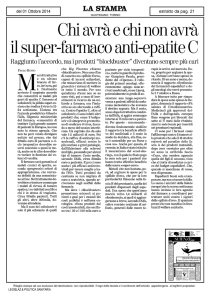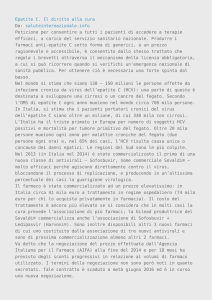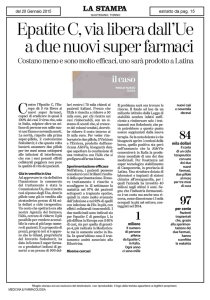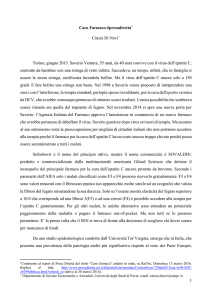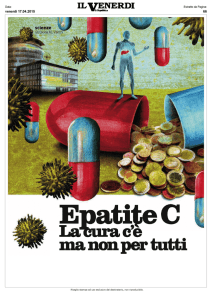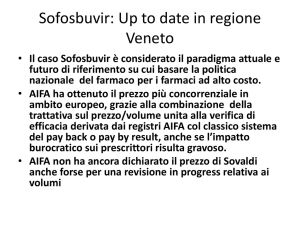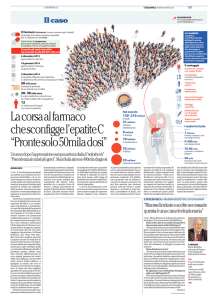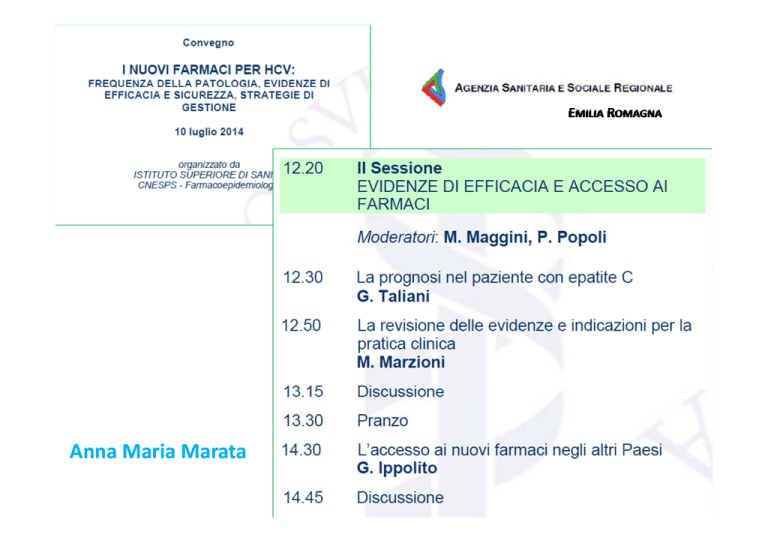
EMILIA ROMAGNA
Anna Maria Marata
Anna Maria Marata
I farmaci per l’epatite C: I farmaci per l’epatite C: la situazione registrativa
la situazione registrativa europea
Inibitori delle proteasi
Inibitori della RNA polimerasi
boceprevir
telaprevir
Sofosbuvir
Usi compassionevoli
Usi compassionevoli
simeprevir
daclatasvir
2011
2013
2014
sofosbuvir+
f b i + ledispavir
l di
i +
ribavirina)
ombitasvir e dasabuvir +
ribavirina
……..
………
Prossimo futuro
Prezzo di Prezzo di sofosbuvir
sofosbuvir per 12 settimane di trattamento
paese
USA
Regno Unito
G
Germania
i
Francia
€
USA
61.700
61
700
41.900 35.000
48 500
48.500
56.000
660
Egitto
Mozambico, Kenya, 660
Myammar, India
660
Generico
95 ‐ 198
Prezzo di produzione
p
(stimato)
$
84.000
84
000
57.000
66 000
66.000
76.000
900
900
900
130‐270
50 99
50 ‐
Sofosbuvir: Paesi
Sofosbuvir: Paesi europei
in cui
in cui è commercializzato
è commercializzato:
Germania Regno Unito/Scozia
Austria
Svezia
Finlandia
Francia
……..
….Lista
….Lista in continuo aggiornamento
in continuo aggiornamento
Il primo accesso a questi farmaci è stato attraverso l’uso compassionevole: …….il parere di EMA
l’uso compassionevole:
il parere di EMA
L’obiettivo di EMA
The aim of the CHMP assessment and opinion on a compassionate‐use programme of new medicinal products is to ensure a common approach, whenever p
possible, regarding the criteria and , g
g
conditions of use under Member States' legislation. The opinion provides recommendations to the EU Member States
recommendations to the EU Member States that are considering setting up such a programme, and its implementation is not mandatory In addition to describing which
mandatory. In addition to describing which patients may benefit from the medicine, it explains how to use the medicine and gives i f
information on safety. The assessment i
f
Th
report and conditions of use of sofosbuvir in this setting will be published shortly on the Agency’s website. L’obiettivo di EMA
The opinion concerns the use of sofosbuvir as part of a compassionate‐
use programme, for the treatment of f h
f
adults infected with chronic HCV who are also:
actively on the waiting list for liver transplantation and require treatment to prevent graft reinfection with HCV;
or who have undergone liver t
transplantation and have aggressive, l t ti
dh
i
recurrent HCV infection resulting in progressive and worsening liver
progressive and worsening liver disease and are at high risk of death or decompensated liver failure within 12 months if left untreated.
I documenti prodotti in Europa
da
da aprile a giugno 2014
aprile a giugno 2014
29 aprile 2014
29 aprile 2014
16 giugno 2014
16 giugno 2014
Cosa è successo in Francia
Cosa è successo in Francia A settembre 2013 A
settembre 2013 sofosbuvir è stato è stato
oggetto di una Autorisation Temporaire d’Utilisation (ATU) che lo concedeva a:
pazienti in attesa di trapianto
d
pazienti trapiantati con reinfezione da pazienti trapiantati con reinfezione da
HCV aggressiva ed una attesa di vita (senza trattamento) < 12 mesi.
Francia: le raccomandazioni di HAS 14 Maggio 2014
Scozia: le raccomandazioni di
Scottish Medicines
Consortium (SMC) 14 Maggio 2014
SMC restriction: Sofosbuvir is accepted for use in patients with genotypes 1 to 6. Use in treatment‐naive patients with genotype 2 is restricted to those who are ineligible for, or are unable to tolerate, peginterferon alfa. Use of the 24‐week interferon‐free regimen of sofosbuvir in combination with ribavirin in patients with genotype 3 is restricted to those who are ineligible for, or are unable to tolerate, peginterferon alfa. Sofosbuvir in combination with ribavirin, or peginterferon plus ribavirin, produced sustained virological suppression in patients with all genotypes of hepatitis C. It is the first medicine licensed for use in interferon‐free regimens and may be associated h fi
di i li
df
i i
f
f
i
d
b
i d
with improved tolerability compared to standard interferon‐based regimens. 16 i
16 giugno 2014
2014
Cosa è successo in Gran Bretagna (NICE)
La consultazione è stata chiusa il 4 luglio 2014
4 luglio 2014
Il “Second Appraisal Committee meeting” avrà luogo il 15 Luglio 2014
15 Luglio 2014
“The available evidence shows that sofosbuvir is an effective treatment for chronic hepatitis C in certain patients. However, evidence is lacking for some subgroups of patients with chronic hepatitis C, and there are also substantial uncertainties in the evidence base presented by the manufacturer. id
b
t d b th
f t
The Committee has therefore requested further information from The
Committee has therefore requested further information from
the manufacturer before it can decide whether sofosbuvir is a cost‐
effective use of NHS resources.”
16 giugno 2014
Alcuni commenti del NICE
The ERG reviewed the clinical evidence in the manufacturer’s submission. It considered that the manufacturer’s interpretation of the clinical evidence was overall justified and unbiased However the ERG cautioned that most of the
overall justified and unbiased. However, the ERG cautioned that most of the evidence provided did not directly address the decision problem, because of the lack of head‐to‐head studies against current standard of care comparators. I ddi i
In addition, it highlighted that no studies were included that examined the efficacy i hi hli h d h
di
i l d d h
i d h ffi
of sofosbuvir within its licensed indication for treatment‐experienced people with genotype 1 HCV. The ERG also noted that some of the evidence supporting the treatment regimens licensed for use in people with genotype 3 HCV (from VALENCE) should be interpreted with caution because randomisation was broken during the study, and some people were switched from 12 to 24 weeks of g
y
p p
treatment with sofosbuvir plus ribavirin.
……………….. Overall, the ERG was satisfied that the evidence indicated that treatment with sofosbuvir‐based regimens was generally well tolerated and led to fewer adverse events than treatment with peginterferon alfa and ribavirin.
Cosa è successo in Germania
29 Aprile 2014
29 aprile 2014
L’ Institute for Quality and Efficiency in Health Care (
(IQWiG), sulla base delle evidenze scientifiche i ) ll b
d ll
id
i ifi h
disponibili, ha dichiarato che non esistono i presupposti per attribuire al sofosbuvir
ib i
l f b i un generico valore i
l
terapeutico aggiunto rispetto alle terapie disponibili (i
(interferone+
f
ribavirina), soprattutto in relazione ai dati ib i i )
i
l i
id i
disponibili per i diversi genotipi virali (carenti per quanto riguarda pazienti con infezione da genotipo 1, 3, 5, 6). i
d
i i
i f i
d
i 1 3 5 6)
Valutazioni del documento IQWIG (1) ( )
Valutazioni del documento IQWIG (2) La LG dell’OMS
Aprile 2014
At the time of writing (December 2013), six drugs At
the time of writing (December 2013) six drugs
are licensed for the treatment of HCV – standard interferon (IFN) or pegylated
( ) p gy
interferon alpha p
(PEG‐IFN), ribavirin (RBV), the protease inhibitors (PIs) boceprevir, simeprevir and telaprevir, and the nucleotide analog polymerase inhibitor sofosbuvir.
The limitations of treatment include high cost, the need for sophisticated laboratory tests and trained clinicians, as well as the limited efficacy and high toxicity of some of the medicines. It is anticipated that the number of medicines for the treatment of HCV will expand rapidly over the coming years, and WHO plans to periodicall pdate these g idelines to incl de ne l licensed
periodically update these guidelines to include newly licensed drugs. Elementi comuni ai documenti europei
Tutti i documenti: contengono dati epidemiologici contengono dati epidemiologici
(frequenza dell’infezione, prevalenza dei genotipi …..)
presentano un
presentano un’analisi
analisi dettagliata/critica delle prove di dettagliata/critica delle prove di
efficacia in funzione del: ‐ genotipo
genotipo,
‐ quadro istologico ‐ caratteristiche del paziente caratteristiche del paziente
‐ rispetto all’attuale standard di cura
presentano una strategia che prevede la definizione di presentano una strategia che prevede la definizione di
priorità d’uso
ribadiscono che l
ribadiscono che l’argomento
argomento è in rapida evoluzione
è in rapida evoluzione
considerano i costi.
Percorso del sofosbuvir in Italia
Percorso del sofosbuvir
Percorso del in Italia
23 novembre 2013: Positive opinion EMA 17 gennaio 2014: EU t i
EU autorizzazione alla commercializzazione
i
ll
i li
i
10 marzo 2014:
10
marzo 2014:
esaminato per la 1° volta da CTS
decisione di fare una valutazione accelerata e non inserirlo in Cnn
Epatite C ‐ Procedura negoziale Sovaldi (sofosbuvir) e accesso gratuito al farmaco
09/07/2014
L’Agenzia Italiana del Farmaco (AIFA) comunica che la ditta Gilead non ha ritenuto possibile LAgenzia Italiana del Farmaco (AIFA) comunica che la ditta Gilead
non ha ritenuto possibile
presentarsi alla riunione del Comitato Prezzi e Rimborso indetta per lo scorso 4 luglio al fine di concludere la procedura negoziale del prodotto Sovaldi (sofosbuvir) ed ha chiesto una proroga fino al 29 settembre 2014.
proroga fino al 29 settembre 2014.
Indipendentemente dall’attività di negoziazione del prezzo del medicinale, è già attiva una procedura di fornitura gratuita del farmaco, per rendere disponibile da subito il medicinale ai pazienti affetti da epatite C nei casi più urgenti, quali quelli di pazienti con:
i i ff i d
i C i
i iù
i
li
lli di
i i
recidiva severa di epatite dopo trapianto di fegato (epatite fibrosante colestatica o epatite cronica con grado di fibrosi >F2 METAVIR)
cirrosi scompensata in lista per trapianto epatico (MELD < 25)
cirrosi scompensata in lista per trapianto epatico (MELD < 25).
Il medicinale verrà fornito secondo le modalità previste dal D.M. 08/05/2003 (Uso Compassionevole) e a tal proposito la Gilead ha attivato un indirizzo di posta elettronica epatitec@gilead com a cui i soli medici potranno inoltrare le richieste per i pazienti che [email protected]
a cui i soli medici potranno inoltrare le richieste per i pazienti che
rientrino nei criteri indicati.
In tale occasione si ribadisce, vista l’urgenza del trattamento di tali pazienti, l’importanza da parte degli operatori sanitari coinvolti ed in particolare dei Comitati Etici, di valutare tempestivamente l’inserimento degli stessi nel programma di accesso gratuito al farmaco.
In conclusione
è urgente,
urgente, anche per il nostro Paese:
definire una strategia per i pazienti più gravi
definire una strategia per i pazienti più gravi
produrre un documento che definisca per i farmaci d
disponibili le raccomandazioni d’uso e le priorità di bl l
d
d’
l
àd
accesso considerando ‐ le caratteristiche della malattia e la sua evoluzione clinica
‐ l’ampia disponibilità (a breve termine) di farmaci efficaci e che consentiranno terapie più tollerabili p p
e di più breve durata
‐ la sostenibilità economica.
la sostenibilità economica

